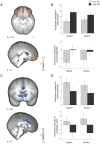How expert advice influences decision making
- PMID: 23185425
- PMCID: PMC3504100
- DOI: 10.1371/journal.pone.0049748
How expert advice influences decision making
Abstract
People often use expert advice when making decisions in our society, but how we are influenced by this advice has yet to be understood. To address this, using functional magnetic resonance imaging, we provided expert and novice advice to participants during an estimation task. Participants reported that they valued expert advice more than novice advice, and activity in the ventral striatum correlated with this valuation, even before decisions with the advice were made. When using advice, participants compared their initial opinion to their advisor's opinion. This comparison, termed the "opinion difference", influenced advice utilization and was represented in reward-sensitive brain regions. Finally, the left lateral orbitofrontal cortex integrated both the size of the opinion difference and the advisor's level of expertise, and average activity in this area correlated with mean advice utilization across participants. Taken together, these findings provide neural evidence for how advice engenders behavioral change during the decision-making process.
Conflict of interest statement
Figures





Similar articles
-
Differential neurobiological effects of expert advice on risky choice in adolescents and adults.Soc Cogn Affect Neurosci. 2012 Jun;7(5):557-67. doi: 10.1093/scan/nss050. Epub 2012 May 3. Soc Cogn Affect Neurosci. 2012. PMID: 22563008 Free PMC article.
-
Hemispheric activation differences in novice and expert clinicians during clinical decision making.Adv Health Sci Educ Theory Pract. 2016 Dec;21(5):921-933. doi: 10.1007/s10459-015-9648-3. Epub 2015 Nov 3. Adv Health Sci Educ Theory Pract. 2016. PMID: 26530736
-
Expert financial advice neurobiologically "Offloads" financial decision-making under risk.PLoS One. 2009;4(3):e4957. doi: 10.1371/journal.pone.0004957. Epub 2009 Mar 24. PLoS One. 2009. PMID: 19308261 Free PMC article.
-
A distributed, hierarchical and recurrent framework for reward-based choice.Nat Rev Neurosci. 2017 Feb 17;18(3):172-182. doi: 10.1038/nrn.2017.7. Nat Rev Neurosci. 2017. PMID: 28209978 Free PMC article. Review.
-
Neural coding of computational factors affecting decision making.Prog Brain Res. 2013;202:289-320. doi: 10.1016/B978-0-444-62604-2.00016-2. Prog Brain Res. 2013. PMID: 23317838 Review.
Cited by
-
The brain's temporal dynamics from a collective decision to individual action.J Neurosci. 2014 Apr 23;34(17):5816-23. doi: 10.1523/JNEUROSCI.4107-13.2014. J Neurosci. 2014. PMID: 24760841 Free PMC article.
-
Independent Neural Computation of Value from Other People's Confidence.J Neurosci. 2017 Jan 18;37(3):673-684. doi: 10.1523/JNEUROSCI.4490-15.2016. J Neurosci. 2017. PMID: 28100748 Free PMC article.
-
The novel cannabinoid receptor GPR55 mediates anxiolytic-like effects in the medial orbital cortex of mice with acute stress.Mol Brain. 2017 Aug 11;10(1):38. doi: 10.1186/s13041-017-0318-7. Mol Brain. 2017. PMID: 28800762 Free PMC article.
-
Regional brain changes occurring during disobedience to "experts" in financial decision-making.PLoS One. 2014 Jan 24;9(1):e87321. doi: 10.1371/journal.pone.0087321. eCollection 2014. PLoS One. 2014. PMID: 24475270 Free PMC article.
-
Effect of Doximity Residency Rankings on Residency Applicants' Program Choices.West J Emerg Med. 2015 Nov;16(6):889-93. doi: 10.5811/westjem.2015.8.27343. Epub 2015 Nov 12. West J Emerg Med. 2015. PMID: 26594285 Free PMC article.
References
-
- U.S. Census Bureau, Service Annual Survey, NAICS Code 5416, 2009 (n.d.).
-
- Harvey N, Fischer I (1997) Taking Advice: Accepting Help, Improving Judgment, and Sharing Responsibility. Organizational Behavior and Human Decision Processes 70: 117–133.
-
- Sniezek JA, Schrah GE, Dalal RS (2004) Improving judgement with prepaid expert advice. Journal of Behavioral Decision Making 17: 173–190.
-
- Jungermann H, Fischer K (2005) Using expertise and experience for giving and taking advice. Betsch T, Haberstroh S, editors Mahwah, NJ: Lawrence Erlbaum.
Publication types
MeSH terms
LinkOut - more resources
Full Text Sources

